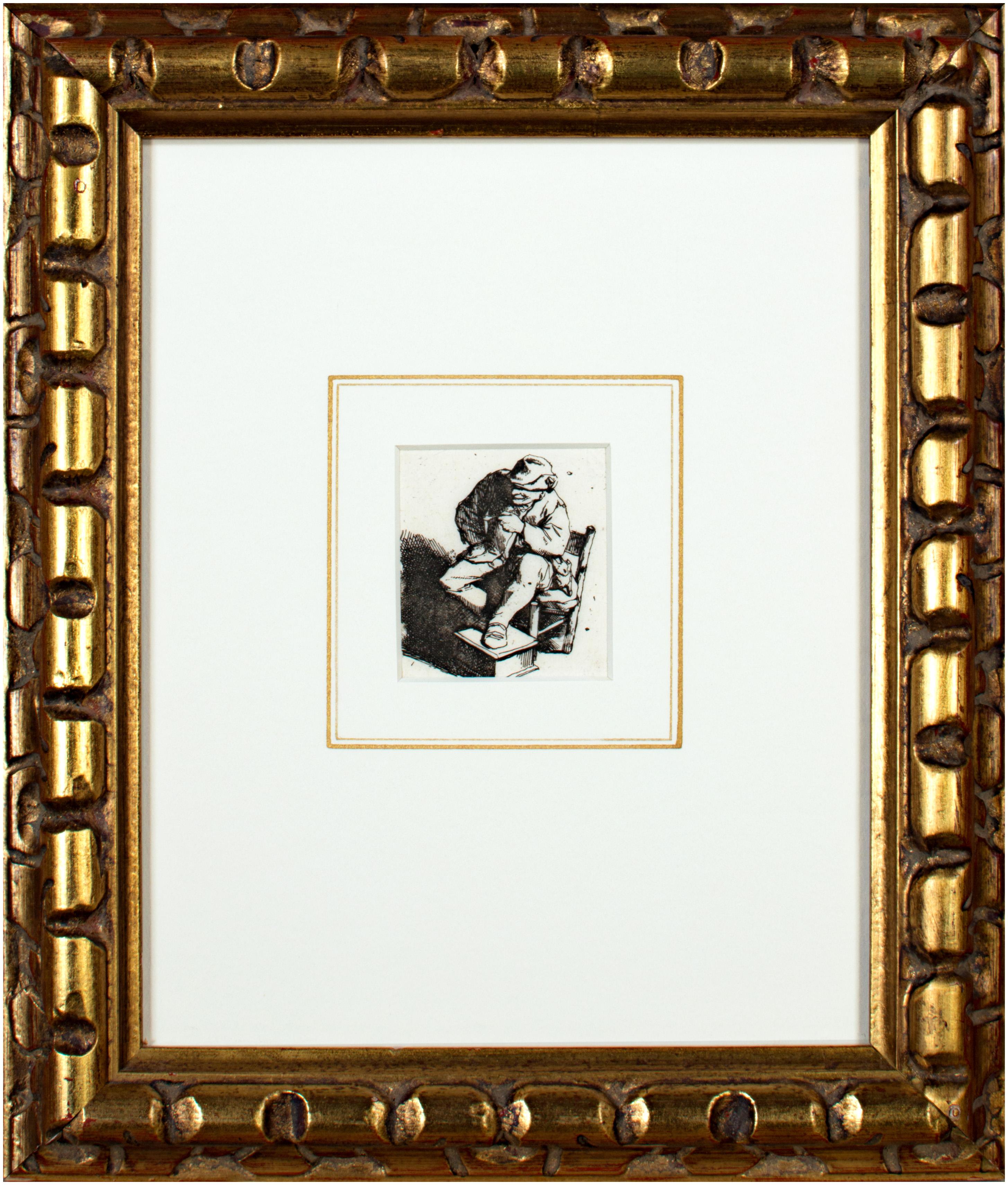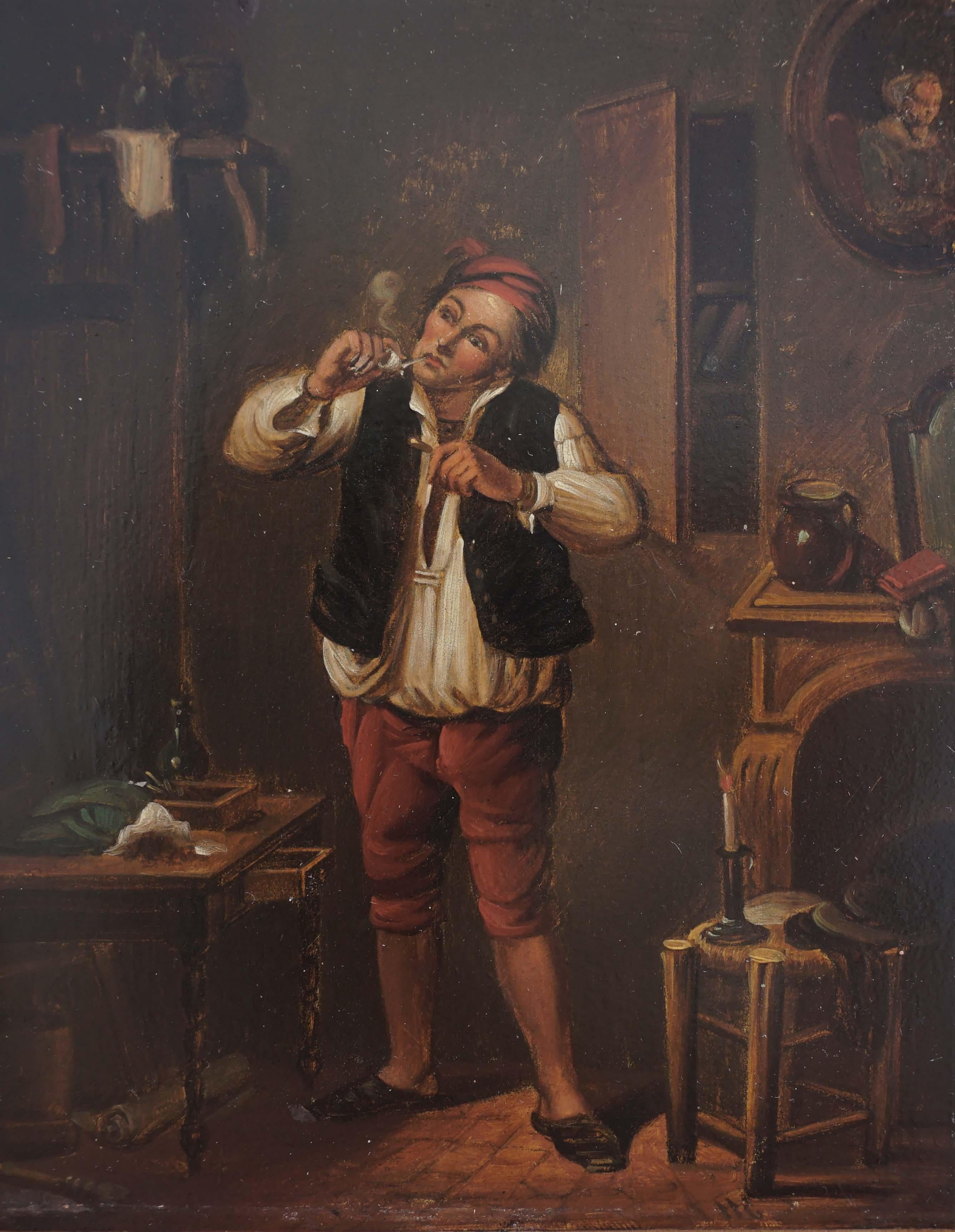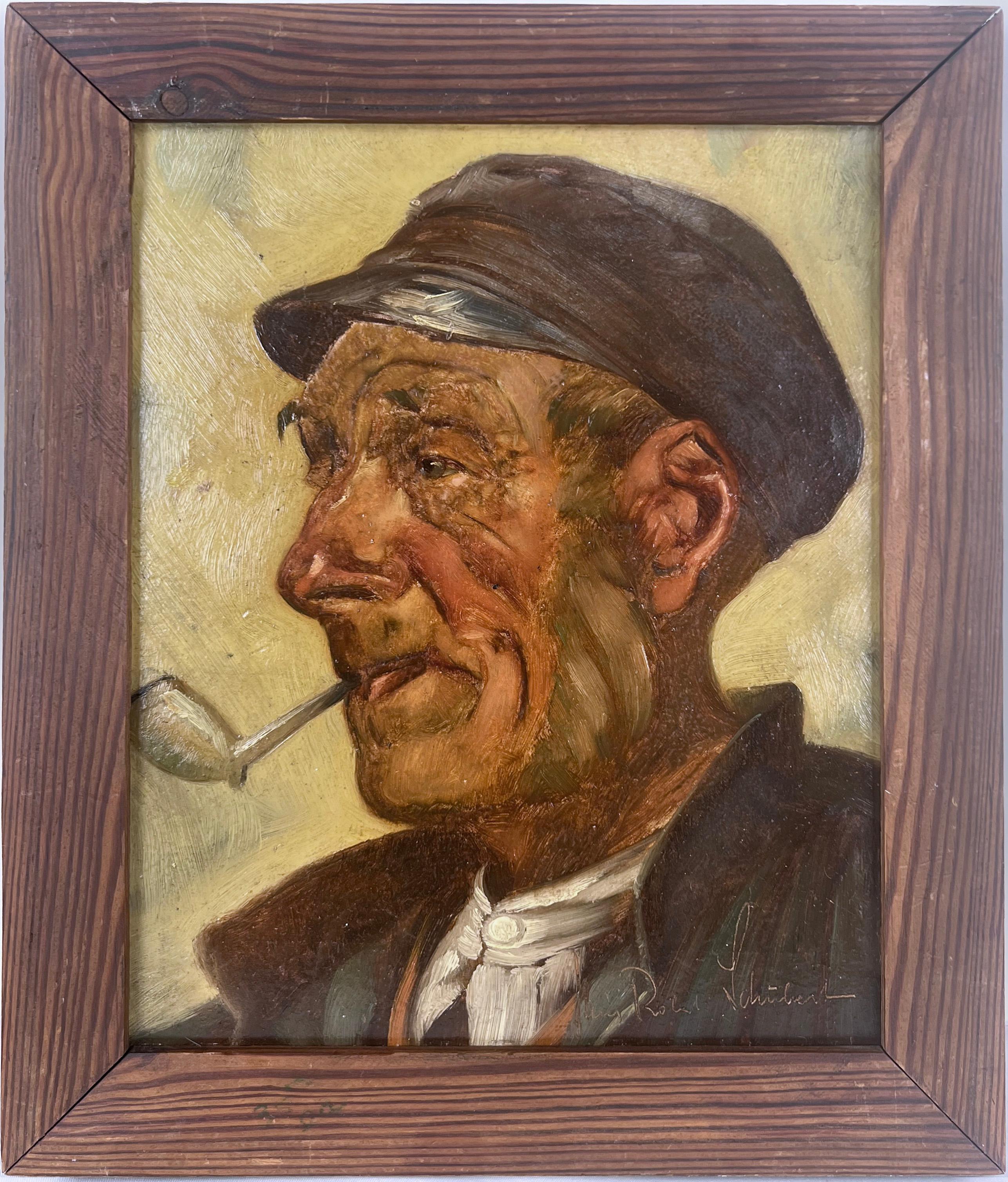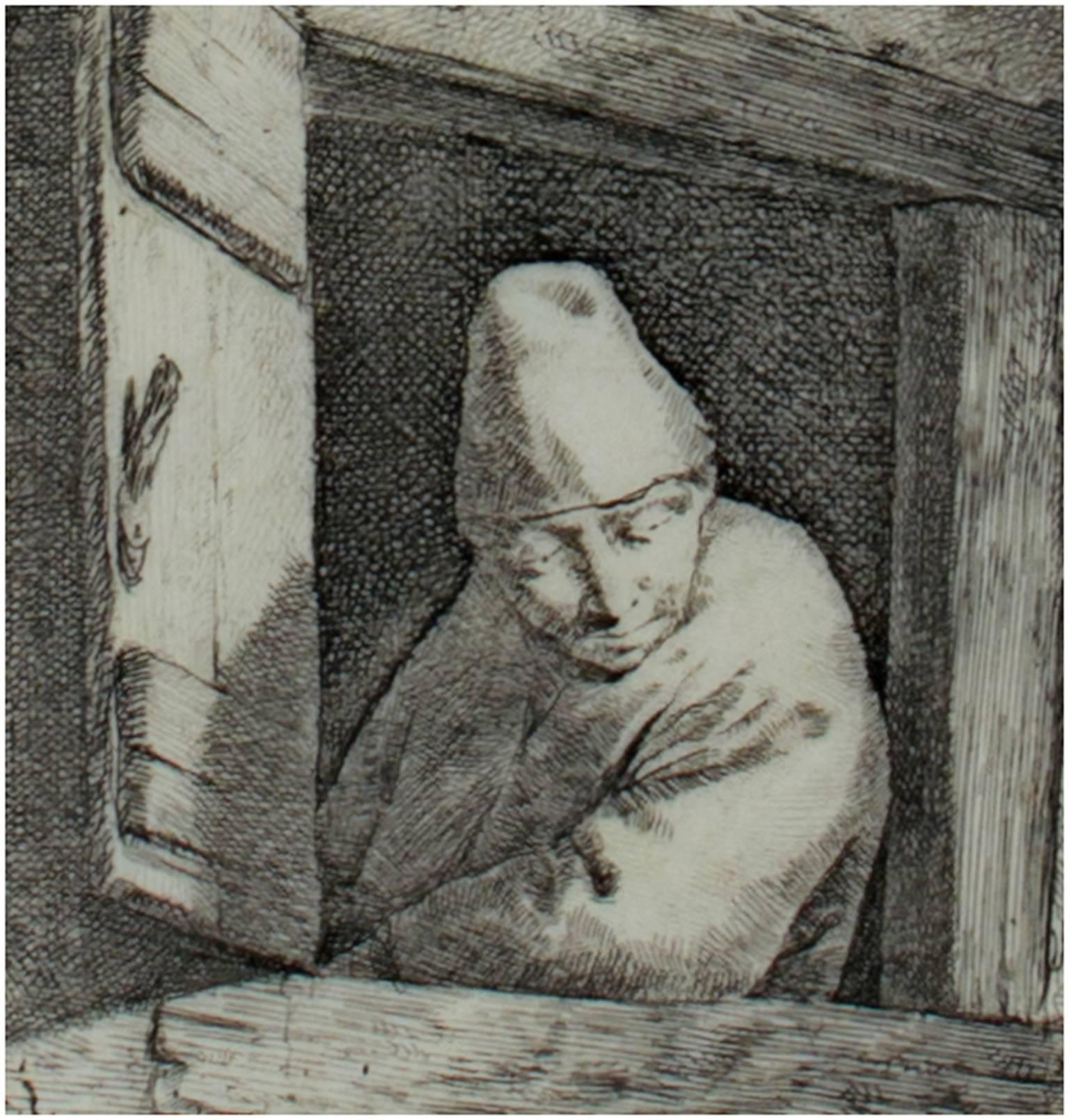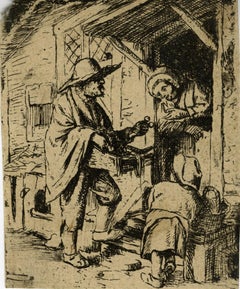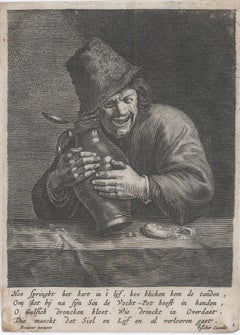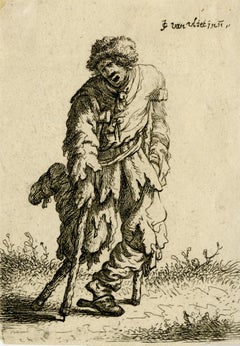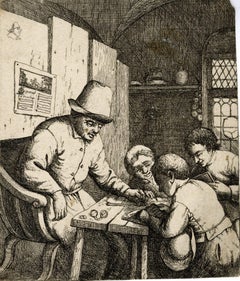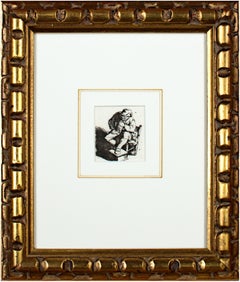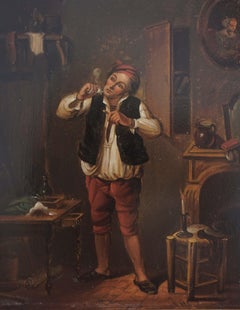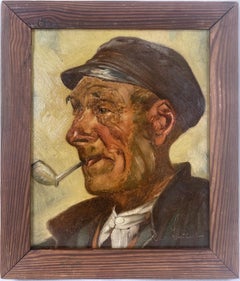Items Similar to The Smoker at the Window by David Deuchar, after Ostade
Want more images or videos?
Request additional images or videos from the seller
1 of 3
The Smoker at the Window by David Deuchar, after Ostade1800
1800
$400
£309.38
€352.22
CA$574.34
A$627.48
CHF 328.86
MX$7,492.30
NOK 4,161.80
SEK 3,880.80
DKK 2,630.49
About the Item
Deuchar, David (after van Ostade). The Smoker at the Window. Edinburgh: 1800. Etching on cream laid paper, 4 1/2 x 4 inches (119 x 100 mm), thread margins. Left top corner expertly repaired, right top corner with some adhesive residue. Notations in pencil on the verso. Condition consistent with age. A reverse image copy etched by David Deuchar afer Ostade, from A Collection of Etchings After the Most Eminent Masters of the Dutch and Flemish Schools particularly Rembrandt, Ostade, Cornelius Bega and Van Vliet, Edinburgh: 22 December, 1803.
[Godefroy 10; Hollstein 11 copy]
- Creation Year:1800
- Dimensions:Height: 4.5 in (11.43 cm)Width: 4 in (10.16 cm)
- Medium:
- Movement & Style:
- After:Adriaen van Ostade (1610 - 1685, Dutch)
- Period:
- Condition:
- Gallery Location:Middletown, NY
- Reference Number:Seller: BH6611stDibs: LU1979212355072
About the Seller
5.0
Vetted Professional Seller
Every seller passes strict standards for authenticity and reliability
Established in 2004
1stDibs seller since 2022
77 sales on 1stDibs
Typical response time: 1 to 2 days
- ShippingRetrieving quote...Shipping from: Middletown, NY
- Return Policy
More From This Seller
View AllThe Spectacle Seller by David Deuchar after Ostade
By Adriaen van Ostade
Located in Middletown, NY
Deuchar, David (after van Ostade). The Spectacle Seller. 1800. Etching on light cream laid paper, 3 3/4 x 3 inches (93 x 75 mm), trimmed at the platemark. Light skinning and some sur...
Category
19th Century Old Masters Portrait Prints
Materials
Etching
To Drink in Excess
By Cornelis Visscher
Located in Middletown, NY
Etching on cream laid paper, full margins. Trimmed at the plate mark. Scattered light caramel colored areas of discoloration in the sheet corners, light skinning on the verso at the ...
Category
Mid-17th Century Old Masters Portrait Prints
Materials
Laid Paper, Etching
Beggar with a Wooden Leg
Located in Middletown, NY
Etching on handmade wove paper, 3 3/4 x 2 3/4 inches (95 x 70 mm), thread margins. Third state (of five), likely printed early 19th century. In very good condition with light handlin...
Category
17th Century Old Masters Figurative Prints
Materials
Etching, Handmade Paper
The School Master by David Deuchar after Ostade
By Adriaen van Ostade
Located in Middletown, NY
Deuchar, David (after van Ostade). The School Master. Edinburgh: c1800. Etching on cream wove paper, 5 5/8 x 4 1/2 inches (134 x 114 mm), trimmed at the platemark. Adhesive residue a...
Category
19th Century Old Masters Portrait Prints
Materials
Handmade Paper, Etching
The Organ Grinder
By Adriaen van Ostade
Located in Middletown, NY
Etching on cream laid paper with a large heraldic watermark which is partially trimmed, 4 3/16 x 3 5/8 inches (105 x 84 mm), margins trimmed but preserving the signature in the lower...
Category
17th Century Old Masters Portrait Prints
Materials
Etching
Seaman in petticoat breeches and slops, smoking a pipe, carrying a carpetbag.
Located in Middletown, NY
English School, 18th century
Pen and black ink with gray wash on cream laid paper, 9 1/4 x 5 inches (238 x132 mm). 1/4 inch repaired loss, top center, to the left of the figure’s h...
Category
18th Century Realist Portrait Drawings and Watercolors
Materials
Ink, Watercolor, Laid Paper, Pen
You May Also Like
'The Smoker (Le Fumeur)' original etching by Cornelis-Pietersz Bega
By Cornelis Bega
Located in Milwaukee, WI
'The Smoker (Le Fumeur)' is an original etching by the celebrated Dutch painter and printmaker Cornelis-Pietersz Bega. It presents a genre scene of the type Bega was best known for: Bega's principal subjects were genre representations of taverns, domestic interiors and villages. He depicted nursing mothers, prostitutes, drunks, gamblers and fools such as quack doctors and alchemists. In this case, he shows a man seated on a chair with his foot on a flat stool and holding a smoking pipe. For Bega, this representation was more of a caricature than it was an image of a specific person, and such genre scenes would have held allegorical and symbolic meaning for the seventeenth-century viewer. During the seventeenth century, the Dutch of all levels of society consumed tobacco and alcohol, and these were an important part of the Dutch economy and a major source of wealth. At the same time, however, moralists and ministers sought to curb intoxication: they openly described drinking and smoking as sinful, immoral, and a general threat to one’s reputation. This paradox is reflected in prints such as this, which inherently carry the national pride of the Dutch economy alongside a moral warning in a print that could be just as easily consumed and collected.
2.5 x 2.25 inches, print
12.38 x 10.38 inches, frame
Framed to conservation standards using archival materials including 100 percent rag matting and mounting materials. Housed in a gold finish Spanish-style wood moulding.
Overall good and stable condition; margins cut to plate; some wrinkling in the corners from previous mounting; housed in a new custom frame.
Cornelis Bega was born into prosperous circumstances. His mother, Maria Cornelis, inherited half the estate (gold, silver, paintings, drawings and prints) and all of the red chalk drawings of her father, Cornelis Cornelisz van Haarlem, a renowned Mannerist artist. Bega's father was Pieter Jansz Begijn (d 1648), a gold and silversmith.
Like other family members, Bega was probably Catholic. Houbraken's claim that Bega studied with Adriaen van Ostade is likely to be correct; this was probably before 24 April 1653, when Bega joined Vincent Laurentsz. van der Vinne in Frankfurt for a journey through Germany, Switzerland and France. Bega had returned to Haarlem by 1 September 1654, at which time he joined the Guild of St Luke; he was already a competent draughtsman, as indicated by his first extant dated work, Interior with a Nursing Mother (1652; Frankfurt am Main, Städel. Kstinst.), and by a remarkable double portrait (Amsterdam, Rijksmuseum) drawn by him and Leendert van der Cooghen in 1654.
Bega painted, drew, etched and made counterproofs in a wide variety of materials on different types of small-scale supports. He may have been the first Dutch artist to make monotypes, but this remains controversial. Approximately 160 paintings, 80 drawings and six monotypes by Bega have been catalogued, as well as around 34 etchings.
Bega's principal subjects were genre representations of taverns, domestic interiors and villages. He depicted nursing mothers, prostitutes, drunks, smokers, gamblers and fools such as quack doctors and alchemists. Less common subjects include the ridiculed or pestered woman, as in Two Figures and Mother with a Spirits Bottle (c. 1662; Gouda, Stedel, Museum Catharina Gasthuis) and The Inn (etching), as well as witty satires on traditional scenes of middle-class music-makers, such as the Music Lesson (1663; Paris, Petit Palace).
Bega's early paintings, such as the Weaver's Family (c. 1652; St Petersburg, Hermitage), are freely executed, dark and coarse, recalling the many-figured peasant subjects of van Ostade. Between c. 1660 and 1664 he began to paint genre scenes with fewer figures, which are finely articulated, colourful and psychologically expressive, for example Two Men Singing (1662; Dublin, N.G.). His exquisite, late fijnschilderen ('fine painting') manner, evident in The Alchemist (1663; Malibu, Getty Museum), compares well with that of Gerrit Dou.
As a draughtsman Bega is noted for his single-figure studies, executed mainly in black and white chalk on blue paper or red chalk on white paper. None of the studies, which were drawn naer het leven (from life), seem to relate to a painting or etching. Bega traded drawings or shared models with other artists of the Haarlem school, including van der Cooghen, Gerrit Berckheyde, Dirck Helmbreker and Cornelis Visscher. These artists drew chalk figure studies in a very similar style, characterised by regular and precise parallel shading and well-defined forms; their drawings, especially those of Bega and Berckheyde, have been frequently confused. Unlike the realistic figure studies, Bega's etchings depict interiors with figures or single figures in the manner of van Ostade; the compositions, often with masterful chiaroscuro effects, reflect most closely the paintings of the 1650s.
Bega is likely to have remained in Haarlem, where he paid dues to the Guild in 1661. He probably died from the plague; fees for his expensive funeral at St. Bavo's were paid on 30 August 1664. Among the artists he influenced were Thomas Wijck, Jan Steen, Richard Brakenburg (1650-1702) and Cornelis Dusart. Painters such as R. Oostrzaen ( fl ?1656) and Jacob Toorenvliet...
Category
17th Century Old Masters Figurative Prints
Materials
Paper, Etching
The Smoker and the Drinker
By Adriaen van Ostade
Located in San Francisco, CA
Artist: Adriaen Van Ostade (Dutch, 1610-1685)
Title: The Smoker and the Drinker
Year: 1650
Medium: Etching
Paper: Laid paper
Image (plate mark) size...
Category
Late 17th Century Old Masters Figurative Prints
Materials
Etching
17th Century Genre Painting -- The Pipe Smoker
By Flemish School, 17th Century
Located in Soquel, CA
Wonderful genre painting from 18th Century of pipe smoker. Signed lower right edge with monogram "I I E". Oil paint on copper. Condition: good: minor wear/rubbing from frame's rabbet...
Category
Mid-17th Century Realist Figurative Paintings
Materials
Copper
Portrait of a Man Smoking a Pipe in Oil on Masonite
Located in Soquel, CA
Portrait of a Man Smoking a Pipe in Oil on Masonite
Detailed portrait of a man with a pipe by Heinz Robert Schubert (German, 1912-2001 approx.). A man wearing a short-brimmed hat is...
Category
1940s Realist Portrait Paintings
Materials
Masonite, Oil
17th century etching black and white dramatic window figure scene
By Cornelis Bega
Located in Milwaukee, WI
"Man Looking Through a Window" is an original etching by Cornelis-Pietersz Bega. It depicts a figure leaning through a window. Publisher: Pearce #37.
3 1/8" x 3" art
14 3/4" x 13 1/...
Category
Mid-17th Century Old Masters Figurative Prints
Materials
Etching
Enjoying a Smoke
By Fritz Wagner
Located in Belgravia, London, London
Oil on canvas
Canvas size: 9.5 x 7 inches
Framed size: 13.25 x 11 inches
Signed upper right
Provenance: Private collection, Herefordshire
Category
19th Century Portrait Paintings
Materials
Canvas, Oil
More Ways To Browse
Antique Smoker
Andrew Scott
Andy Warhol Cowboy
Andy Warhol Queen
Andy Warhol Rebel Without A Cause
Ariel Alex Katz
Art Breastfeeding
Banksy Offset Lithograph
Beethoven Print
Chuck Close Phil
Fedor Lowenstein
George Washington Lithograph
Glen Friedman
Howdy Doody
Leroy Neiman Etchings
Longo Gretchen
Matisse Pasiphae
Picasso Francoise

